Abstract
Propionibacterium acnes, P. avidum, and P. granulosum were quantitatively measured in 50 young adults. The scalp, forehead, external auditory canal, alae nasi, anterior nares, groin, rectum, and antecubital and popliteal fossa were sampled. These represent various cutaneous microenvironments, differing in moisture, density of sweat, sebaceous glands, and extent of anaerobiosis. These studies show that the propionibacteria are ubiquitous on the skin, with P. acnes predominant in both prevalence and population, especially in areas rich in sebum. P. granulosum recovery paralled that of P. acnes, but the density was significantly lower. P. avidum was found mainly in moist areas and the retum, suggesting an intestinal reservoir.
Full text
PDF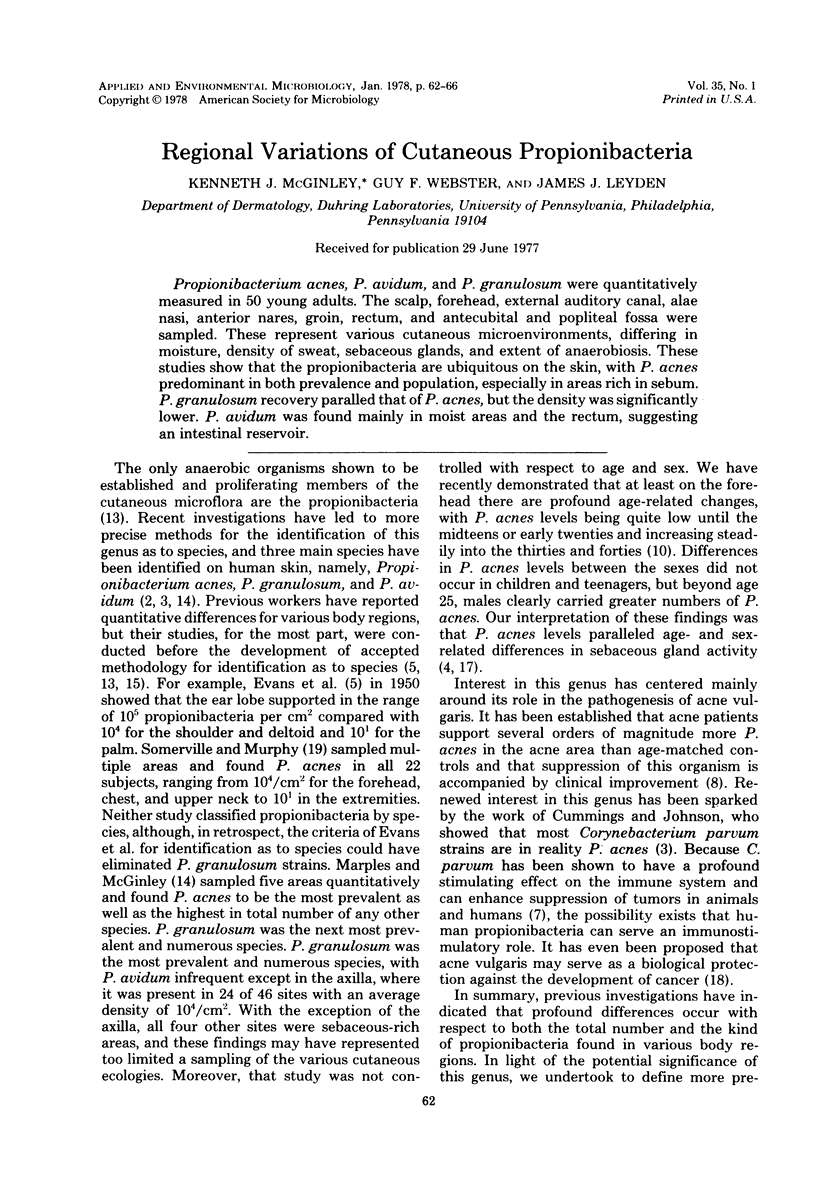
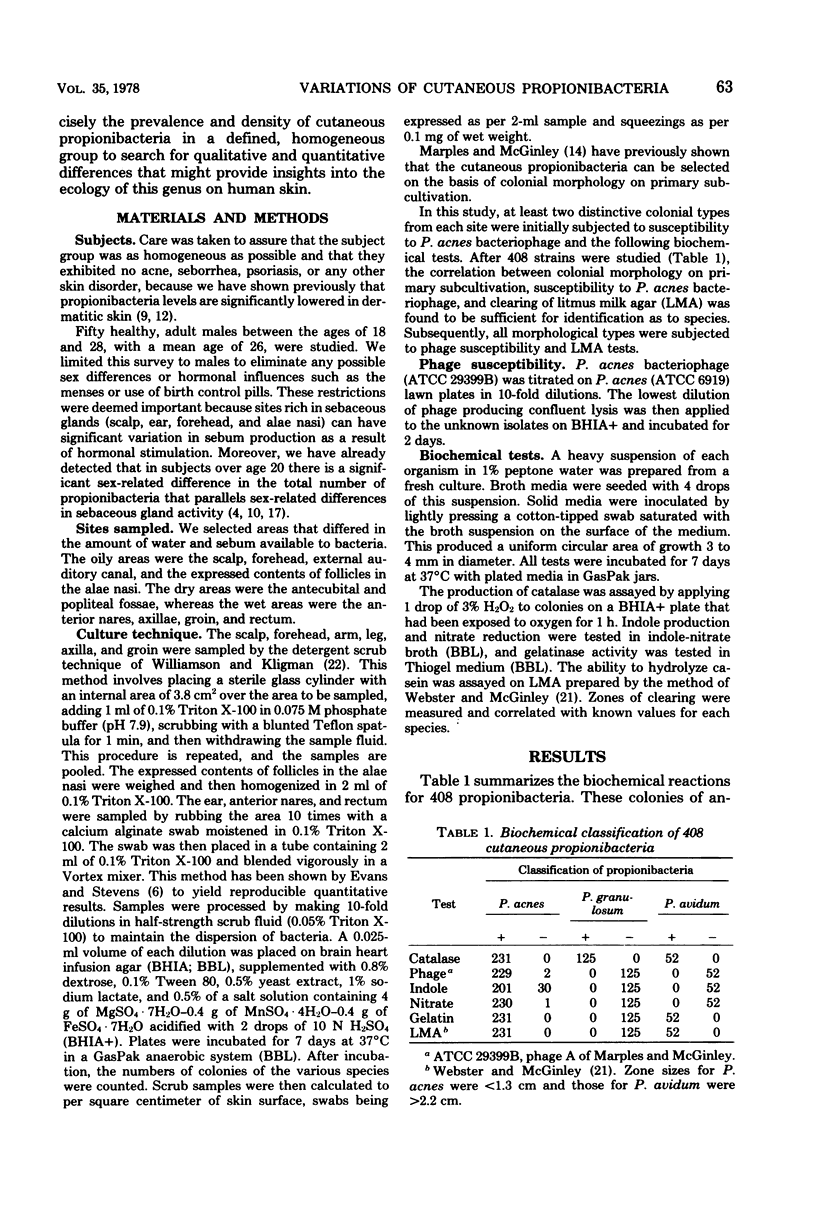
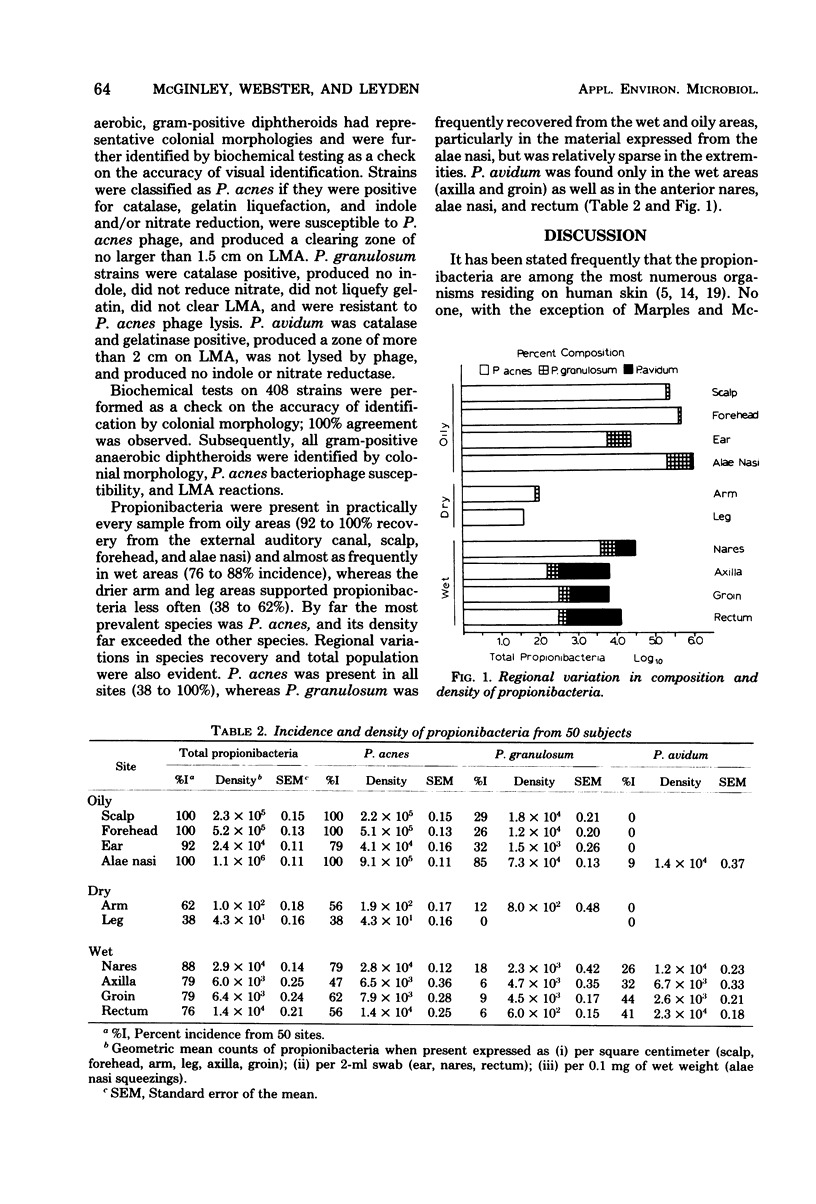
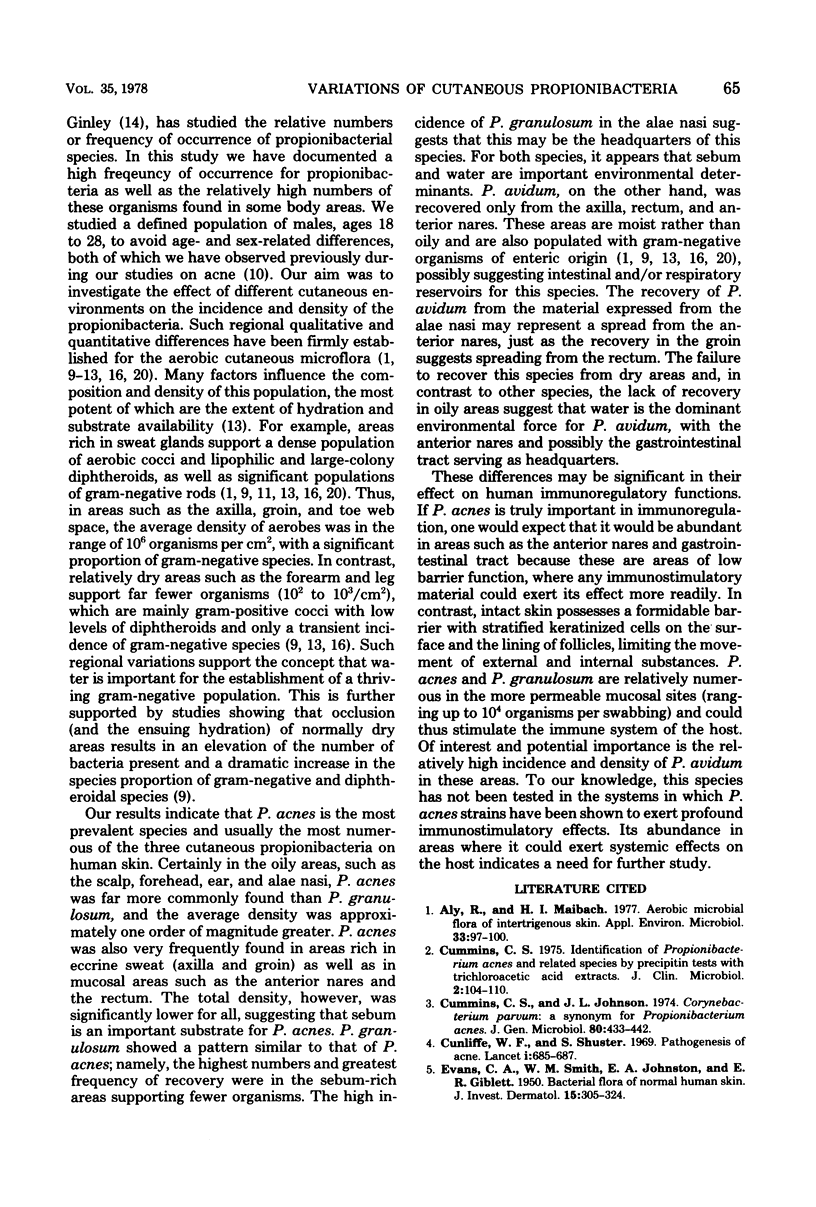
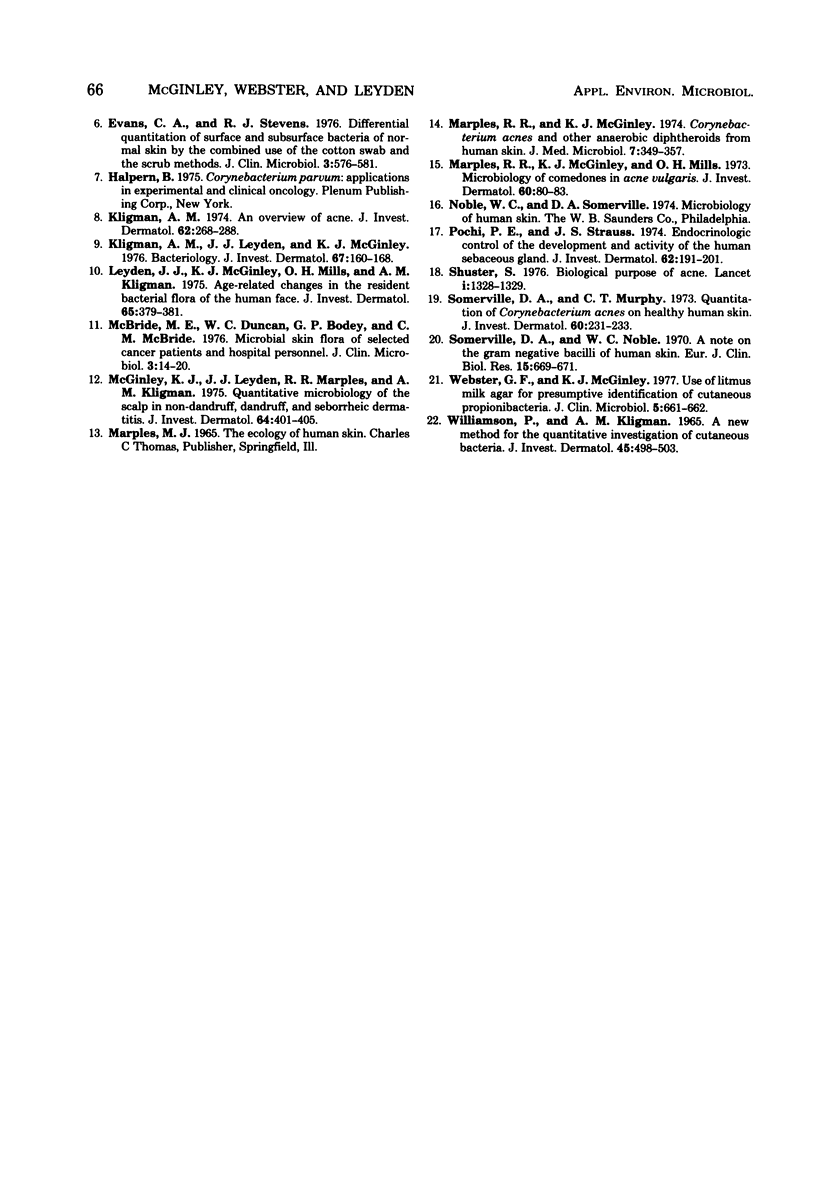
Selected References
These references are in PubMed. This may not be the complete list of references from this article.
- Aly R., Maibach H. I. Aerobic microbial flora of intertrigenous skin. Appl Environ Microbiol. 1977 Jan;33(1):97–100. doi: 10.1128/aem.33.1.97-100.1977. [DOI] [PMC free article] [PubMed] [Google Scholar]
- Cummins C. S. Identification of Propionibacterium acnes and related organisms by precipitin tests with trichloroacetic acid extracts. J Clin Microbiol. 1976 Aug;2(2):104–110. [PMC free article] [PubMed] [Google Scholar]
- Cummins C. S., Johnson J. L. Corynebacterium parvum: a synonym for Propionibacterium acnes? J Gen Microbiol. 1974 Feb;80(2):433–442. doi: 10.1099/00221287-80-2-433. [DOI] [PubMed] [Google Scholar]
- Cunliffe W. J., Shuster S. Pathogenesis of acne. Lancet. 1969 Apr 5;1(7597):685–687. doi: 10.1016/s0140-6736(69)92642-7. [DOI] [PubMed] [Google Scholar]
- EVANS C. A., SMITH W. M., JOHNSTON E. A., GIBLETT E. R. Bacterial flora of the normal human skin. J Invest Dermatol. 1950 Oct;15(4):305–324. doi: 10.1038/jid.1950.105. [DOI] [PubMed] [Google Scholar]
- Evans C. A., Stevens R. J. Differential quantitation of surface and subsurface bacteria of normal skin by the combined use of the cotton swab and the scrub methods. J Clin Microbiol. 1976 Jun;3(6):576–581. doi: 10.1128/jcm.3.6.576-581.1976. [DOI] [PMC free article] [PubMed] [Google Scholar]
- Kligman A. M. An overview of acne. J Invest Dermatol. 1974 Mar;62(3):268–287. doi: 10.1111/1523-1747.ep12676801. [DOI] [PubMed] [Google Scholar]
- Kligman A. M., Leyden J. J., McGinley K. J. Bacteriology. J Invest Dermatol. 1976 Jul;67(1):160–168. doi: 10.1111/1523-1747.ep12513007. [DOI] [PubMed] [Google Scholar]
- Leyden J. J., McGinley K. J., Mills O. H., Kligman A. M. Age-related changes in the resident bacterial flora of the human face. J Invest Dermatol. 1975 Oct;65(4):379–381. doi: 10.1111/1523-1747.ep12607630. [DOI] [PubMed] [Google Scholar]
- Marples R. R., McGinley K. J. Corynebacterium acnes and other anaerobic diphtheroids from human skin. J Med Microbiol. 1974 Aug;7(3):349–357. doi: 10.1099/00222615-7-3-349. [DOI] [PubMed] [Google Scholar]
- Marples R. R., McGinley K. J., Mills O. H. Microbiology of comedones in acne vulgaris. J Invest Dermatol. 1973 Feb;60(2):80–83. doi: 10.1111/1523-1747.ep12724149. [DOI] [PubMed] [Google Scholar]
- McBride M. E., Duncan W. C., Bodey G. P., McBride C. M. Microbial skin flora of selected cancer patients and hospital personnel. J Clin Microbiol. 1976 Jan;3(1):14–20. doi: 10.1128/jcm.3.1.14-20.1976. [DOI] [PMC free article] [PubMed] [Google Scholar]
- McGinley K. J., Leyden J. J., Marples R. R., Kligman A. M. Quantitative microbiology of the scalp in non-dandruff, dandruff, and seborrheic dermatitis. J Invest Dermatol. 1975 Jun;64(6):401–405. doi: 10.1111/1523-1747.ep12512335. [DOI] [PubMed] [Google Scholar]
- Pochi P. E., Strauss J. S. Endocrinologic control of the development and activity of the human sebaceous gland. J Invest Dermatol. 1974 Mar;62(3):191–201. doi: 10.1111/1523-1747.ep12676783. [DOI] [PubMed] [Google Scholar]
- Shuster S. Biological purpose of acne. Lancet. 1976 Jun 19;1(7973):1328–1329. doi: 10.1016/s0140-6736(76)92657-x. [DOI] [PubMed] [Google Scholar]
- Somerville D. A., Murphy C. T. Quantitation of Corynebacterium acnes on healthy human skin. J Invest Dermatol. 1973 Apr;60(4):231–233. doi: 10.1111/1523-1747.ep12724525. [DOI] [PubMed] [Google Scholar]
- Somerville D. A., Noble W. C. A note on the gram negative bacilli of human skin. Rev Eur Etud Clin Biol. 1970 Jun-Jul;15(6):669–671. [PubMed] [Google Scholar]
- Webster G. F., McGinley K. J. Use of litmus milk agar for presumptive identification of cutaneous propionibacteria. J Clin Microbiol. 1977 Jun;5(6):661–662. doi: 10.1128/jcm.5.6.661-662.1977. [DOI] [PMC free article] [PubMed] [Google Scholar]
- Williamson P., Kligman A. M. A new method for the quantitative investigation of cutaneous bacteria. J Invest Dermatol. 1965 Dec;45(6):498–503. doi: 10.1038/jid.1965.164. [DOI] [PubMed] [Google Scholar]


